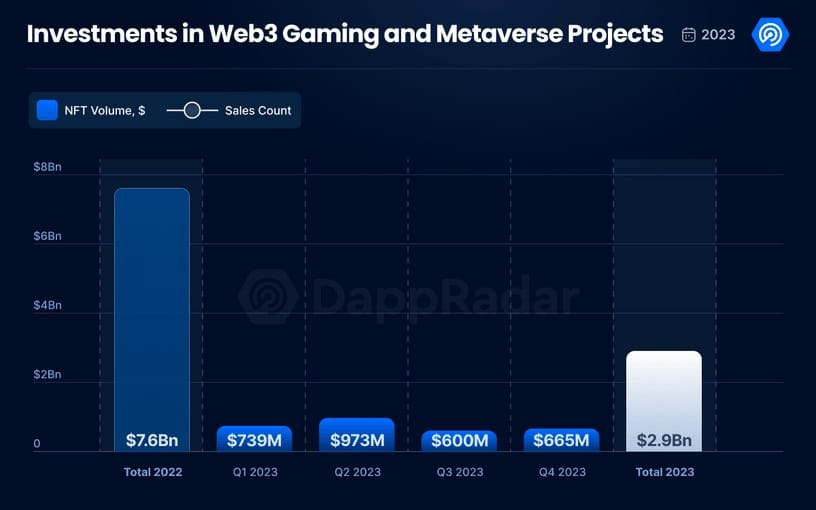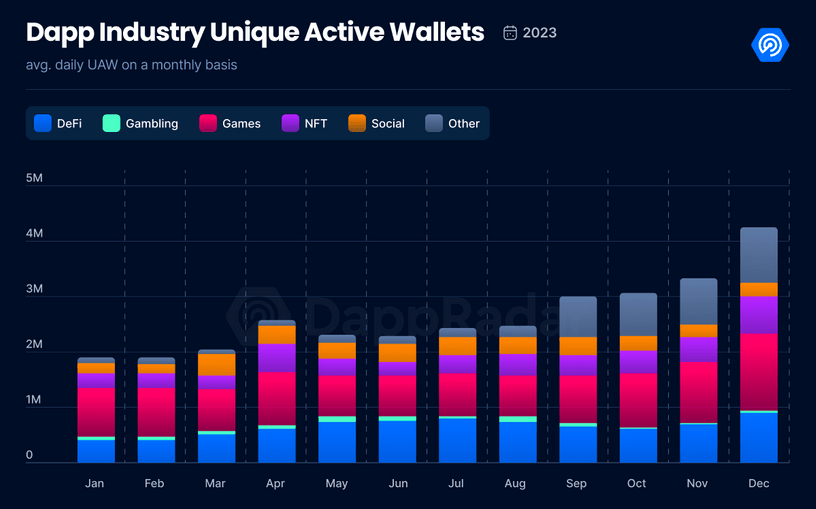Blockchain Games Reigned Supreme in 2023 + More Crypto News

Get your daily, bite-sized digest of blockchain and crypto news – investigating the stories flying under the radar of today’s news.
In today’s edition:
- Banxa Brings Fiat On-Ramps to Sui, Off-Ramps Coming Soon
- 2023 Crypto News: Blockchain Games Reigned Supreme Last Year
- Neo Opens Hong Kong Office to Expand Its APAC Presence
__________
Banxa Brings Fiat On-Ramps to Sui, Off-Ramps Coming Soon
Payments infrastructure provider Banxa has announced it will add the SUI token to its platform. Per the press release shared with Cryptonews, the integration will increase access to the Sui blockchain for users globally.
This will be done thanks to a suite of Banxa’s global and local payment methods. These have processed over $3 billion in transactions since its launch in 2014, Banxa said.
Furthermore, Mysten Labs’ Sui Wallet will enable users to purchase SUI tokens through Banxa’s on-ramp and, once fully integrated, utilize its off-ramp solution.
There will be no transaction gateway fees for buying SUI on Banxa for a limited time.
“Thanks to this integration, users of some of the most established Web3 platforms, such as OKX and MetaMask, will now have seamless, and initially, feeless, access to Sui,” said the press release.
Additionally, developers building on Sui will be able to leverage Banxa’s features to add more functionalities and compliance measures to their decentralized apps (dapps).
For example, it said, the non-fungible token (NFT) checkout solution will provide an enhanced NFT selling experience for end users.
Developers can also improve the overall user experience by reducing friction in the onboarding and offboarding processes.
Blockchain Games Reigned Supreme in 2023
“While the 2023 bear market caused the unfortunate demise of various prominent Web3 games, others have shown how resilient the industry can be,” according to the latest DappRadar blockchain gaming report making crypto news rounds.
The report noted “significant strides” in adoption. Major traditional gaming studios like Ubisoft joined the space.
Mainstream platforms such as Epic Games Store, Google Play Store, and the iOS AppStore have all accepted Web3 games – indicating a broader embrace of this technology.
During the year, $2.9 billion was invested across 163 deals in Web3 gaming and metaverse projects. “Despite a notable decrease from the $7.6 billion invested in 2022, the sector continued to attract substantial funding, underscoring their ongoing relevance and moreover its incredible potential to attract a much bigger audience,” the press release said.

Victor Yu, co-founder of the data-sharing protocol and AI-powered gaming app CARV, commented that,
“The convergence of top-tier talent, leading game studios, and fine-tuning during the bear market has washed out the tourists. What remains are robust teams dedicated to delivering innovative gaming experiences. This maturity paves the way for intent-based, user-centric applications, and an environment ripe for mainstream adoption. With any luck, this bull run is the start of something special.”
Per the report, blockchain games “reigned supreme.” They accounted for 34% of Dapp activities and attracted 1.1 million active users daily.

WAX is the top gaming blockchain, seeing over 3 million new wallets and processing 4.7 billion gaming transactions.
Klaytn and Near have seen “a phenomenal increase” in unique gaming wallets, growing by 72,857% and 21,132%.
Among the games, Alien Worlds took the first spot, with 2.25 million new unique wallets.
Meanwhile, Gods Unchained has set a new high with $209 million in trading volume and 4.71 million sales – the most among all gaming NFT collections.
As for blockchains, Ethereum is still at the top with $347 million in in-game NFT trades. Immutable X doubled its trading volume, “showing robust growth.”
When it comes to virtual worlds, Otherdeed for Otherside recorded $365 million in land trades. This is 30% of the total virtual world Dapp trading volume.
Neo Opens Hong Kong Office to Expand Its APAC Presence
Open-source, community-driven platform Neo officially opened its Hong Kong office. It is located within Cyberport, a digital tech and Web3 hub.
Per the press release shared with Cryptonews, “Neo is joining the Cyberport Incubation Programme where it will avail of financial support alongside key networking support and opportunities.”
As countries across Asia have deployed new regulatory frameworks for the adoption of digital assets, Hong Kong has clearly emerged as a significant player in the new financial market, it said.
Neo will add to this drive and forge relationships with local enterprises, universities, and talent to foster a distributed Smart Economy network.
Da Hongfei, Founder of Neo and CEO of Neo Global Development, said that the new office marks “a significant step in our continued expansion across Asia and aligning our efforts with the already excellent work being done by the Hong Kong government authorities to solidify Hong Kong as a Web3 hub.”
The post Blockchain Games Reigned Supreme in 2023 + More Crypto News appeared first on Cryptonews.
Blockchain Games Reigned Supreme in 2023 + More Crypto News

Get your daily, bite-sized digest of blockchain and crypto news – investigating the stories flying under the radar of today’s news.
In today’s edition:
- Banxa Brings Fiat On-Ramps to Sui, Off-Ramps Coming Soon
- 2023 Crypto News: Blockchain Games Reigned Supreme Last Year
- Neo Opens Hong Kong Office to Expand Its APAC Presence
__________
Banxa Brings Fiat On-Ramps to Sui, Off-Ramps Coming Soon
Payments infrastructure provider Banxa has announced it will add the SUI token to its platform. Per the press release shared with Cryptonews, the integration will increase access to the Sui blockchain for users globally.
This will be done thanks to a suite of Banxa’s global and local payment methods. These have processed over $3 billion in transactions since its launch in 2014, Banxa said.
Furthermore, Mysten Labs’ Sui Wallet will enable users to purchase SUI tokens through Banxa’s on-ramp and, once fully integrated, utilize its off-ramp solution.
There will be no transaction gateway fees for buying SUI on Banxa for a limited time.
“Thanks to this integration, users of some of the most established Web3 platforms, such as OKX and MetaMask, will now have seamless, and initially, feeless, access to Sui,” said the press release.
Additionally, developers building on Sui will be able to leverage Banxa’s features to add more functionalities and compliance measures to their decentralized apps (dapps).
For example, it said, the non-fungible token (NFT) checkout solution will provide an enhanced NFT selling experience for end users.
Developers can also improve the overall user experience by reducing friction in the onboarding and offboarding processes.
Blockchain Games Reigned Supreme in 2023
“While the 2023 bear market caused the unfortunate demise of various prominent Web3 games, others have shown how resilient the industry can be,” according to the latest DappRadar blockchain gaming report making crypto news rounds.
The report noted “significant strides” in adoption. Major traditional gaming studios like Ubisoft joined the space.
Mainstream platforms such as Epic Games Store, Google Play Store, and the iOS AppStore have all accepted Web3 games – indicating a broader embrace of this technology.
During the year, $2.9 billion was invested across 163 deals in Web3 gaming and metaverse projects. “Despite a notable decrease from the $7.6 billion invested in 2022, the sector continued to attract substantial funding, underscoring their ongoing relevance and moreover its incredible potential to attract a much bigger audience,” the press release said.

Victor Yu, co-founder of the data-sharing protocol and AI-powered gaming app CARV, commented that,
“The convergence of top-tier talent, leading game studios, and fine-tuning during the bear market has washed out the tourists. What remains are robust teams dedicated to delivering innovative gaming experiences. This maturity paves the way for intent-based, user-centric applications, and an environment ripe for mainstream adoption. With any luck, this bull run is the start of something special.”
Per the report, blockchain games “reigned supreme.” They accounted for 34% of Dapp activities and attracted 1.1 million active users daily.

WAX is the top gaming blockchain, seeing over 3 million new wallets and processing 4.7 billion gaming transactions.
Klaytn and Near have seen “a phenomenal increase” in unique gaming wallets, growing by 72,857% and 21,132%.
Among the games, Alien Worlds took the first spot, with 2.25 million new unique wallets.
Meanwhile, Gods Unchained has set a new high with $209 million in trading volume and 4.71 million sales – the most among all gaming NFT collections.
As for blockchains, Ethereum is still at the top with $347 million in in-game NFT trades. Immutable X doubled its trading volume, “showing robust growth.”
When it comes to virtual worlds, Otherdeed for Otherside recorded $365 million in land trades. This is 30% of the total virtual world Dapp trading volume.
Neo Opens Hong Kong Office to Expand Its APAC Presence
Open-source, community-driven platform Neo officially opened its Hong Kong office. It is located within Cyberport, a digital tech and Web3 hub.
Per the press release shared with Cryptonews, “Neo is joining the Cyberport Incubation Programme where it will avail of financial support alongside key networking support and opportunities.”
As countries across Asia have deployed new regulatory frameworks for the adoption of digital assets, Hong Kong has clearly emerged as a significant player in the new financial market, it said.
Neo will add to this drive and forge relationships with local enterprises, universities, and talent to foster a distributed Smart Economy network.
Da Hongfei, Founder of Neo and CEO of Neo Global Development, said that the new office marks “a significant step in our continued expansion across Asia and aligning our efforts with the already excellent work being done by the Hong Kong government authorities to solidify Hong Kong as a Web3 hub.”
The post Blockchain Games Reigned Supreme in 2023 + More Crypto News appeared first on Cryptonews.

